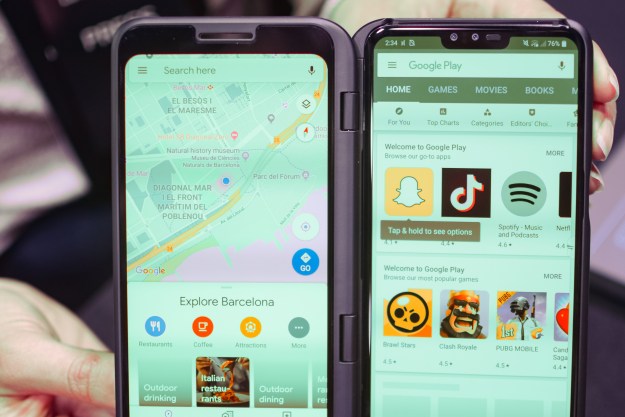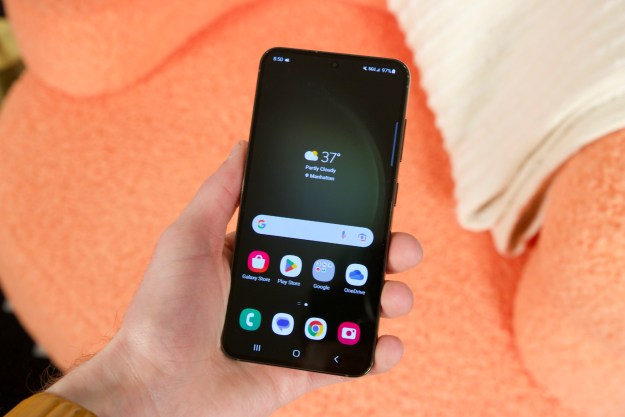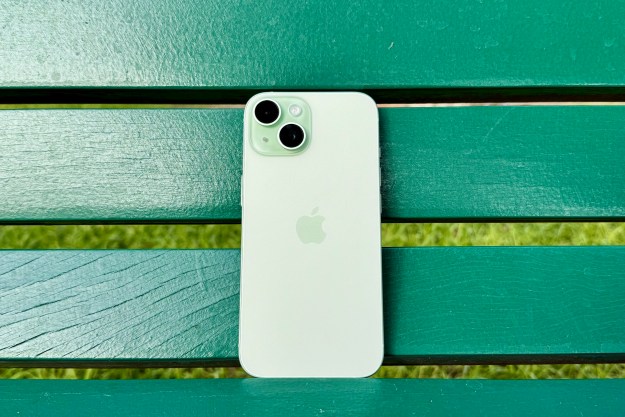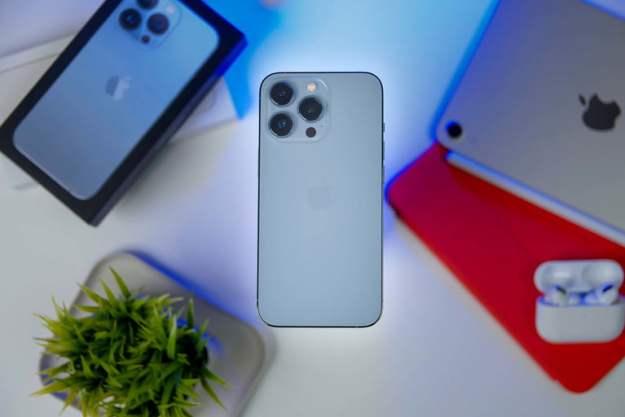
“The promise of 5G may not be enough to stir interest in the uninspired LG V50 ThinQ.”
- Strong screen
- Versatile cameras
- Promise of 5G
- Video portrait mode is fun
- Bigger battery
- Light-up 5G logo looks tacky
- Dual-screen attachment not coming to the U.S.
- Hardly different from last year’s V40
- User interface could use some work
The Samsung Galaxy S10 5G isn’t the only 5G phone around — LG’s new V50 ThinQ can also connect to the next-gen mobile network (well, whenever it goes online). And while the phone doesn’t bring any radically new features over last year’s V40 ThinQ, there are a few nice upgrades that could make it worth a look.
Same form factor and display
The LG V50 ThinQ is around the same size as last year’s V40 — that’s impressive, as early speculation suggested the first 5G phones would be bulky. Instead, the V50 is elegant, especially with the triple-camera setup, which rests under the rear glass (like the new LG G8 ThinQ) instead of sitting in a separate module.
But the aesthetic is somewhat ruined by the 5G logo on the back, which is placed awkwardly at the top. Now this isn’t so bad by itself, but as soon as you’re connected to 5G networks, the logo will light up yellow. The V50 is coming to Sprint first, which is why the logo will be yellow, but Digital Trends confirmed carriers have the capability to change the color, and Verizon’s V50 will light up red. It’s tacky and detracts from the otherwise slick look on the back.
The flash sits to the right of the triple cameras, ruining the symmetry, and below is the fingerprint sensor, V50 ThinQ logo, and then LG’s branding. As a result, the back now looks a bit crowded.
Over on the front are notch and dual-lens selfie camera setup at the top. The 6.4-inch OLED screen is sharp, with a 3,120 x 1,440 pixel resolution. We didn’t see any issues with the screen on the V40, so expect more or less of the same with this phone.
Like Samsung, LG is one of the few manufacturers to keep the headphone jack. There’s also a USB-C port at the bottom, next to the Boombox speaker from last year’s G7 ThinQ, as well as a dedicated Google Assistant key and IP68 water resistance.
Performance, battery, and 5G
Like most flagship Android phones in 2019, the V50 is powered by Qualcomm’s Snapdragon 855 processor. It comes with 6GB of RAM and 128GB of internal storage, but there’s a MicroSD card in case you need more. Expect fantastic performance, as this is the most powerful chip in Android phones this year.
There may be kinks with the first 5G phones and networks.
But it’s the choice of modem that makes the LG V50 ThinQ special — it’s Qualcomm’s X50 modem, which enables the phone to connect to 5G networks when they come online, though it will revert back to 4G LTE when 5G is unavailable. The LG G8 ThinQ doesn’t have this modem, so it will always be stuck on 4G LTE.
5G on a supported phone should hit speeds between 1 to 10Gbps, but there are a variety of factors that can affect this, such as how many people there are in the area and the spectrum being used. There’s a good chance you will get 50Mbps or higher. It’s quite like how 4G LTE’s max speed tops out around 300Mbps, but on average most people only see somewhere between 15mbps to 50mbps.
And while some U.S. carriers will be bringing 5G networks online this year, it will be in certain areas in select cities. For example, Sprint announced it would bring its 5G network online starting in May for about 20 square miles in Chicago. So unless you know you’ll be in an area where your carrier will be deploying 5G, there’s no need to rush to get a 5G phone. A full nationwide rollout of 5G could take another two years, if not more.

What will 5G connectivity bring? On your phone, it means faster speeds and lower latency. You’ll be able to download content incredibly fast, stream higher-quality audio and video without interruptions, and we’ll eventually see enhanced applications for augmented reality and virtual reality.
Another reason to perhaps pause before purchasing a 5G phone is that there may be kinks with the first 5G phones and networks. For example, early 4G handsets suffered from poor battery life as the phones searched for 4G signals. Ideally, that won’t happen here, but there’s no saying what problems could arise. Also, as 5G grows and more devices come to market, you won’t need to shell out a lot of money for a 5G device — prices will inevitably drop.
Speaking of the battery, LG has bumped the capacity from 3,300mAh to 4,000mAh. We loved the battery life on the V40, so it should be better here — that is if 5G doesn’t cause excessive battery drain. You can charge it via a USB-C cord with Quick Charge 3.0 fast charging or use a Qi wireless charger.
Clunky U.I., the second screen
The software experience is mostly unchanged, with LG’s user interface layered over Android 9 Pie. It’s manageable, but it’s not our favorite theme, as there is some bloatware, and elements of the interface look clunky and cluttered.
There isn’t much else in terms of new software features on the V50 — it doesn’t have some of the more gimmicky features of the new LG G8 ThinQ — but there is an accessory that can turn the phone into a foldable device. It’s not a foldable phone like the Samsung Galaxy Fold or the Huawei Mate X; instead, the second screen attaches to the V50 like a case. Open it like a book and you can use both screens simultaneously for multitasking. A floating button on the main V50 screen lets you swap content from one screen to the other.
We found the image quality of the V50 to be lacking when compared to competitors.
If you want to leave the case on but only want to use the main screen, you can fold the second screen back so it’s touching the rear of the V50. The downside? When it’s closed, there’s nothing you can see or interact with on the front.You’ll always need to open the phone to check a notification, which is disappointing. Thankfully, you never need to charge the second screen as it wirelessly draws power from the V50.
The whole experience is polished, and there are genuine uses of the second screen that could improve day-to-day tasks. Things like using the calendar app on one screen and Gmail on the other or watching YouTube while messaging a friend on the other screen. You can even game on one screen and use the second one as a controller — not unlike Nintendo’s 3DS. Well, as much as it’d be interesting to see how this worked out over a longer period of use, the secondary screen attachment is not coming to the U.S., so you’re stuck with just the phone.
Same cameras
The-triple camera setup is back. It’s a standard 12-megapixel lens with a f/1.5 aperture and optical image stabilization paired with a wide-angle 16-megapixel lens with a f/1.9 aperture, as well as a 12-megapixel telephoto lens with a f/2.4 aperture, which offers 2x optical zoom. It’s a versatile system, and it’s one several other smartphones mimic, including the Huawei Mate 20 Pro and Samsung’s new Galaxy S10. This camera array is unchanged from the V40, which is a shame, as we found the image quality to be lacking when compared to competitors. Expect the same here.
The V50 does bring two features from the LG G8 — Video Portrait and Night View. The latter is when the camera stacks 10 images for better low-light photos, and the former lets you add a bokeh effect to subjects and objects in video (just like Portrait Mode). Video Portrait is quite fun and does a decent job of accurately adding blur. We haven’t tested Night View enough to comment on it yet.
Over on the front in the notch cutout are two selfie cameras — an 8-megapixel lens with a f/1.9 aperture and a wide-angle 5-megapixel lens with a f/2.2 aperture. The second lens is better-suited to capturing group selfies, but we’d have liked to see an even wider lens on the front.
Price and availability
LG hasn’t announced the price of the V50 ThinQ yet, though it’s safe to say we can expect it to cost $900 or more, as that was the original cost of the V40 ThinQ. It will launch in the spring as Sprint’s first 5G phone, and will come to Verizon in the summer.
The V50 ThinQ will be expensive, and with the second screen not coming to the U.S., the minor updates — which are uninspiring — aren’t enough to justify the price, especially since you’ll hardly be able to use 5G for the next year at the least. It’s still a solid phone, but from our early impressions, it’s not quite as robust as the Samsung Galaxy S10 5G.
Editors' Recommendations
- The best LG phones for 2022
- LG’s next flagship phone, the V60 ThinQ, leaks after MWC cancellation
- LG’s got some cool dual-screen smartphone trickery up its sleeve for IFA 2019
- LG’s V50 ThinQ is a different take on the folding phone, and it supports 5G
- The modern-looking Axon 10 Pro 5G is ZTE’s first 5G-ready smartphone













